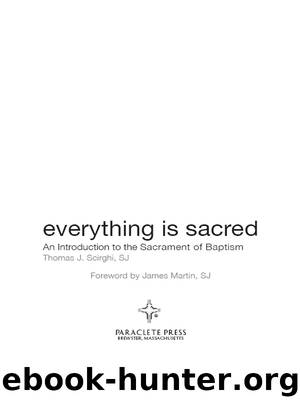Everything is Sacred : An Introduction to the Sacrament of Baptism by Thomas J. Scirghi SJ

Author:Thomas J. Scirghi, SJ
Language: eng
Format: epub
Publisher: Paraclete Press
four
the structure and symbols of baptism today
The best way to begin the study of theology is in church, with the celebration of ritual. Rituals tell the story of the sacraments and of the Christian faith in a succinct and expressive form. In the community's prayer and song, as well as in its symbols and gestures, we are introduced to the fundamentals of the faith. Here we learn by doing. The church's worship provides the primary setting for learning about our faith. If you want to learn about a religious group, then you should join them for worship.
The second place for learning about religious faith is the academy, or the classroom, where we reflect on and analyze what we have witnessed. Here we study the tradition of the church, exploring its history and doctrine, in ways suited to a contemporary understanding. In other words, we seek to make sense of and apply a tradition, one that is centuries old, to our current context of time and place. Theology is “done” in the church as well as in the classroom; that is, we learn our theology through the dual activities of worship and study.
As mentioned earlier, theology is the practice of “faith seeking understanding”; that is, theology begins with an act of faith, with a person's response to God's call. But in order to deepen one's relationship with God, one needs to reflect on this call and respond in the light of a rich tradition. This response shapes one's whole life, not just an hour on Sunday. Through the study of the tradition—the practical and the ethical—believers learn how to shape their lives, conforming themselves to the body of Christ. Greater understanding leads to a deepening of one's faith. So we can again say that theology begins in church.
Consider how the first followers of Jesus Christ kept the faith by meeting for worship to give thanks and praise to God. This was their initial response by which they dedicated Sunday as the “Lord's Day,” a little Easter, commemorating the day on which Christ was raised from death. Eventually questions and problems arose concerning their faith. And as the original disciples passed away it became necessary to record and interpret their personal experience and understanding to future generations. This recording and interpreting took place especially with the spread of Christianity to other cultures, as believers faced the problem of translating the teaching into languages and cultures with different symbols and customs.
Perhaps the study of theology can be summed up with the question, asked within the context of ritual celebration, why do we do this? The Christian tradition unfolds from the regular practice of sacramental worship. The ritual of baptism begins this unfolding of the Christian story. Let us now look at this ritual in some detail.
There are five parts to the structure of a typical infant baptism. These are, first, the welcoming of the candidate along with family and friends to the church; second, the Liturgy of the Word, in which we hear
Download
This site does not store any files on its server. We only index and link to content provided by other sites. Please contact the content providers to delete copyright contents if any and email us, we'll remove relevant links or contents immediately.
Resisting Happiness by Matthew Kelly(3197)
The Social Psychology of Inequality by Unknown(2770)
Designing Your Life by Bill Burnett(2605)
Day by Elie Wiesel(2596)
The Giving Tree by Shel Silverstein(2177)
Angels of God: The Bible, the Church and the Heavenly Hosts by Mike Aquilina(1870)
Human Design by Chetan Parkyn(1859)
The Supreme Gift by Paulo Coelho(1800)
Jesus of Nazareth by Joseph Ratzinger(1709)
Augustine: Conversions to Confessions by Robin Lane Fox(1688)
Hostage to the Devil by Malachi Martin(1676)
7 Secrets of Divine Mercy by Vinny Flynn(1620)
Dark Mysteries of the Vatican by H. Paul Jeffers(1607)
The Vatican Pimpernel by Brian Fleming(1588)
St. Thomas Aquinas by G. K. Chesterton(1557)
Saints & Angels by Doreen Virtue(1530)
The Ratline by Philippe Sands(1425)
My Daily Catholic Bible, NABRE by Thigpen Edited by Dr. Paul(1418)
Called to Life by Jacques Philippe(1410)
